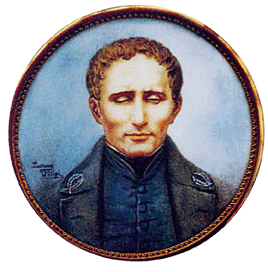See your name in Braille on the American Foundation for the Blind’s web site: http://www.afb.org/braillebug/thenamegame.asp
Braille translator (http://libbraille.org/translator.php), and Alphabet (http://libbraille.org/alphabet.php)
Braille is the most well-known method of writing to allow the non-sighted to read, but there are other methods (known generically as scripts or codes). Here are 15 other codes you may not be aware of.
I can translate any language into Braille sign: Standard Braille | American Braille | Arabic | Bharati-Devanagari | British | Croation | Czech | Dutch | French | German | Italian | Japanese | Korean | Portuguese | Québécois | Spanish | Swedish | Unified English | Vietnamese
Omniglot – Another Braille alphabet reference page.
Standard Braille alphabet
Braille generally consists of cells of 6 raised dots and the presence or absence of dots gives the coding for the symbol, providing a 64 characters Braille alphabet. This system has been adapted to many international languages
Letters:
| a ⠁ | b ⠃ | c ⠉ | d⠙ | e ⠑ | f ⠋ | g⠛ | h ⠓ | i ⠊ | j ⠚ |
| k ⠅ | l ⠇ | m ⠍ | n⠝ | o ⠕ | p ⠏ | q⠟ | r ⠗ | s ⠎ | t ⠞ |
| u ⠥ | v ⠧ | w ⠺ | x⠭ | y ⠽ | z ⠵ |
Numbers:
| 1 ⠼⠁ | 2 ⠼⠃ | 3⠼⠉ | 4 ⠼⠙ | 5⠼⠑ | 6 ⠼⠋ | 7⠼⠛ | 8 ⠼⠓ | 9⠼⠊ | 0 ⠼⠚ |
Numbers: addition of the number sign (⠼ or DOTS-3456) before numerals Check Braille transcription of “1234”
Uppercase: a “capital sign” (⠠ or DOTS-6) is inserted before a capital letter, or [TODO] two capital signs are inserted to indicate that the entire word is capitalized Check Braille transcription of “Braille BRAILLE”
Grade 1 Braille
(or uncontracted) braille has nothing to do with first grade. Most children learn grade 2 (contracted) braille from kindergarten on. In recent years, some teachers have chosen to begin teaching grade 1 braille first, transitioning to grade 2 braille by the mid-elementary years. There is currently no research that supports the superiority of one approach over the other.
Grade 2 Braille
Grade 2 Braille was introduced as a space-saving alternative to grade 1 braille. In grade 2 braille, a cell can represent a shortened form of a word. Many cell combinations have been created to represent common words, making this the most popular of the grades of braille. There are part-word contractions, which often stand in for common suffixes or prefixes, and whole-word contractions, in which a single cell represents an entire commonly used word. Words may be abbreviated by using a single letter to represent the entire word, using a special symbol to precede either the first or last letter of the word while truncating the rest of the word, using a double-letter contraction such as “bb” or “cc”, or removing most or all of the vowels in a word in order to shorten it. A complex system of styles, rules, and usage has been developed for this grade of braille.

Computer Braille
The standard Braille system has been extended to 8 dots for computer systems in order to handle additional attributes.
You can convert some text to american Computer Braille using this online American computer Braille translator.


